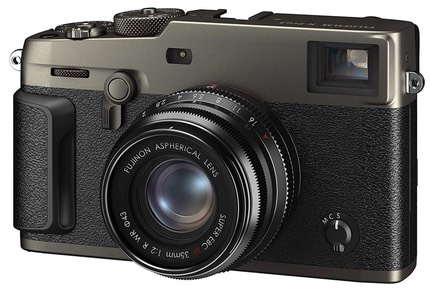
Fujifilm today officially announced the X-Pro3 after teasing it last month in Japan. For the most part it's what you'd expect: an update of the X-Pro2 to current technologies. That includes using the 26mp X-Trans sensor, incorporating the latest X-Processor 4, as well as updating the displays.
While the Fujifilm press release leads with some down-in-the-weeds things, the big news here is really those displays.
The EVF portion of the hybrid viewfinder has been updated to a 3.69m dot OLED that covers 97% of the sRGB Color Space. Moreover, at high speed it runs at either 100 fps or 200 fps (with a unique black frame signal to make for visual smoothness frame to frame). The overlay for the OVF side of the viewfinder has been updated, as well.
On the back of the camera, the tilting and touchscreen rear LCD actually lives mostly with its face to the camera. That's because there's an additional "Memory LCD" on its back side to provide settings information full time. The main 1.6m dot LCD folds down from the back now, and flips to an 180° position max.
The X-Pro has always been a unique camera in the market, given its hybrid viewfinder. Personally, I've always found the X-Pro a bit on the gimmicky and clumsy side. I'd be curious as to the actual statistics of how people are using those early X-Pros. In other words, how much of the time they're in optical viewfinder mode versus how much they're in electronic viewfinder mode. I suspect that people aren't switching as much as Fujifilm thinks between the alternatives.
But more to the point, there's another issue that now comes up because of the way Fujifilm is handling the rear LCD. It appears that Fujifilm has a clear design bias in the X-Pro series toward folk who used old rangefinder cameras and don't want to spend time in the menus or even reviewing images on the camera. That audience is, at this point, getting old. Fujifilm also seems to be saying that this same audience isn't all that interested in one of the primary advantages that kicked the digital camera adoption into high gear, that big rear LCD.
Each big "breakthrough" in camera tech that generated a growth spurt in ILC solved a clear user problem. Automatic metering solved the user problem of setting the right exposure. Autofocus solved the user problem of putting focus in the right spot. DSLRs solved the problem of not seeing your results instantly so that you could understand what you might still need to change.
The hypothesis behind the X-Pro design is that there is a group of photographers who know exactly what they're doing and don't need or want to see results most of the time. Call them the Totally Secure-in-What-I'm-Doing Shooters. Okay, maybe, but how many of those folk are there actually? And are they really that secure? Are they not chimping at all? To me, the change in rear display adds another clumsiness to an already somewhat awkward camera.
This is all a long-winded way of saying: what user problem is Fujifilm trying to solve with the X-Pro3? I'm not sure what that is, and I'm pretty sure it isn't for me if I don't know what the user problem was.
Because of that, the X-Pro3 feels a bit more like an experimental playground for some high-end Fujifilm engineers more than as a camera specifically targeted to win over new customers. There's other evidence of that, as well, including the titanium exterior, the spec to 10°C usage, and more. The US$2000 price for an APS-C camera also puts the X-Pro3 in a crowd by itself.
The bulk of the XF buying is still going to be the X-A7, the X-100, the X-T30, and X-T3. Nothing changes in that because of the introduction of the X-Pro3. To me, the X-Pro3 is a little more targeted to catering to the Leica crowd than the general photographer.
Of course, the proof is always in the actual camera use. Given that much of the X-T3 inside migrates to the X-Pro3, it should be a very capable shooter. The question is whether all the exotic add-ons add enough for us to consider it for daily shooting over the X-T3.
Update: after handling the X-Pro3 for a short time, I like it better than I thought I would. That said, I still have two concerns about this camera: (1) the optical viewfinder has been downgraded in several ways, so I'm now less likely to use it, which makes me wonder why I need it and have to spend more for it; and (2) having a touch interface on a rear LCD that isn't accessible in the preferred shooting configuration is another downgrade; if the camera is completely configured exactly how you need it, great, but the minute you have to drop into the menus and use that rear LCD, it's sub-optimal compared to even the X-A7. So I still think this is a camera for a very specific type of shooter. That shooter is not me.
Support this site by purchasing from the following advertiser:
